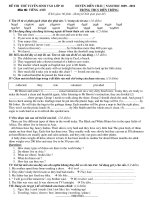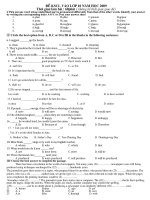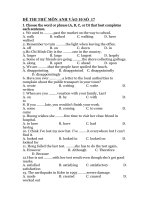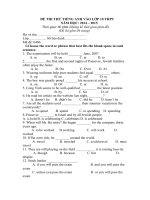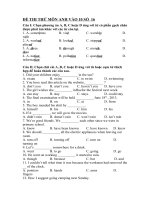DE THI THU TIENG ANH VAO 10 DE SO 8
Bạn đang xem bản rút gọn của tài liệu. Xem và tải ngay bản đầy đủ của tài liệu tại đây (127.73 KB, 15 trang )
ĐỀ LUYỆN THI VÀO 10
MÔN : TIẾNG ANH
THỜI GIAN LÀM BÀI : 60 PHÚT
ĐỀ SỐ 8
I. MULTIPLE CHOICE: (8.0 points)
Mark the letter A, B, C or D on your answer sheet to indicate the word whose underlined part
differs from the other three in pronunciation in each of the following questions.
Question 1: A. talked
B. watched
C. lived
D. stopped
Question 2: A. flood
B. moon
C. food
D. soon
Mark the letter A, B, C or D on your answer sheet to indicate the word that differs from the other
three in the position of primary stress in each of the following questions.
Question 3: A. engineer
B. corporate
C. difficult
D. different
Question 4: A. popular
B. position
C. horrible
D. positive
Mark the letter A, B, C or D on your answer sheet to indicate the underlined part that needs
correction in each of the following questions.
Question 5: Mr. Smith is going to buy a new Japanese car, doesn’t he?
A
B
C
D
Question 6: One of the most urgent problem, facing us now is the need to control population growth.
A
B
C
D
Question 7: If I were you, I didn’t buy that expensive car.
A
B
C
D
Mark the letter A, B, C or D on your answer sheet to indicate the correct answer to each of the
following questions.
Question 8: She turned
A. on
the new job in New York because she didn’t want to move.
B. off
C. up
Question 9: One of my friends
A. what
Question 10: I wish I
A. had finished
is very good at English gives me his tips to learn English well.
B. who
C. which
B. finished
B. studying
C. have finished
B. twice as much as
D. finish
harder to pass the exam.
C. study
Question 12: This laptop is much more user-friendly, but it costs
A. as many as
D. whom
my homework last night.
Question 11: Her teacher suggested she
A. studies
D. down
C. twice as many
D. to study
the other one.
D. so much as
Question 13:
she’s young, she’s the most famous artsan in the village.
A. When
B. Although
C. Whereas
D. In order to
Question 14: With this type of insurance, you’re buying
A. peace
B. satisfaction
Question 15: She has made an
A. application
of mind.
C. calmness
D. contentment
for the job as a nursery teacher because she likes children.
B. applicating
C. apply
D. applicant
Question 16: As I was walking along the street, I saw
10 USD note on
A. a/the
B. the/the
C. a/a
pavement.
D. the/a
Mark the letter A, B, C or D on your answer sheet to indicate the most suitable response to
complete each of the following exchanges.
Question 17: A: “I think we should use less paper so that we can save trees in the forests” ~ B:
“
”
A. You’re welcome!
B. Yes,I’d love to.
C. That’s a good idea!
D. It’s nice of you to say so.
Question 18: John: " I've passed my final exams. " – Tom: "
A. Good luck!
B. Congratulations!
C. Try harder next time!
D. Don’t worry, it’ll be fine.
"
Mark the letter A, B, C or D on your answer sheet to indicate the word(s) CLOSEST in
meaning to the underlined word(s) in each of the following questions.
Question 19: My father still hasn’t really recovered from the death of my mother.
A. looked after
B. taken after
C. gone off
D. got over
Question 20: Yes, we went away on holiday last week, but it rained day in day out.
A. every single day
B. every other day
C. every two days
D. every second day
Mark the letter A, B, C or D on your answer sheet to indicate the word(s) OPPOSITE in meaning to the
underlined word(s) in each of the following questions.
Question 21: All children can attend without paying fees at state schools.
A. primary schools
B. secondary schools
C. high schools
D. independent schools
Question 22: James may get into hot water when driving at full speed after drinking.
A. get into trouble
B. fall into disuse
C. remain calm
D. stay safe
Read the following passage and mark the letter A, B, C, or D on your answer sheet to indicate the
correct word or phrase that best fits each of the numbered blanks.
Television is one of man’s most important means of communication. It brings events and sounds (23)
around the world into millions of homes. A person with a television set can sit in his house and watch the
President making a speech or visit foreign country. He can see a war being fought and watch statesmen try
(24)
about peace. Through television home viewers can see and learn about people, places, and
2
things all over the world. TV even (25)
its viewers out of this world. It brings them (26)
of
America’s astronauts as the astronauts explore outer space. In addition to all these things, television brings
its viewers a steady stream of programs that are designed to entertain. (27)
, TV provides more
entertainment programs than any other kinds. The programs include action-packed dramas, light comedies,
sporting events and motion pictures.
Question 23: A. from
B. add
C. in
D. to
Question 24: A. bring
B. brought
C. bringing
D. to bring
Question 25: A. makes
B. takes
C. puts
D. lets
Question 26: A. cover
Question 27: A. In fact
B. covering
B. Because
C. covered
D. coverage
C. However
D. Therefore
Read the following passage and mark the letter A, B, C, or D on your answer sheet to indicate the
correct answer to each of the questions.
The invention of the phonograph happened quite by accident. Thomas Edison moved to Menlo Park,
New Jersy in 1876, where he established an industrial research laboratory. There, Edison was working on a
carbon telephone transmitter to improve the existing Bell telephone system.
In that laboratory a year later, Edison invented the phonograph while he was trying to improve a
telegraph repeater. He attached a telephone diaphragm to the needle in the telegraph repeater; in this way, he
was able to reproduce a recording that could be played back. After he made some improvements to the
machine, he tested it. He recited “Mary Had a Little Lamb” into the machine and played his voice back to a
very surprised audience.
Question 28: What is the best title for the passage?
A. Thomas Edison’s many inventions
B. Improvements in telephone and telegraph
C. The History of Menlo Park
D. An accidental invention
Question 29: In what year did the invention of phonograph occur?
A. 1876
B. 1877
C. 1878
D. 1879
Question 30: According to the passage, how was the phonograph made?
A. With a telephone needle and a recorder
B. From a recording of a telegraph
C. With only a telegraph repeater
D. From a combination of telephone & telegraph part
Question 31: The word “existing” in the first paragraph means
A. old
B. modern
C. current
Question 32: The word “it” in the passage refers to
.
D. fashionable
.
A. the machine
B. the telephone diaphragm
C. the transmitter
D. the laboratory
II. WRITING: (2points)
Finish the second sentence so that it has a similar meaning to the first one, beginning with the
given words or using suggestions.
Question 33: John has not had his hair cut for over six months.
=> It is……………………………………………………………………………………………
Question 34: Maria says she’d like to have been put in a higher class.
=> Maria wishes………………………………………………………………………………………………
Question 35: It took Mary two hours to travel to the countryside last week.
=> Mary spent…………………………………………………………………………………………………
Question 36: “Don’t make so much noise” the mother said.
=> The mother told ……………………………………………………………………………………….
(ID: e2961) Combine two sentences into a new one using the given words in brackets. Do not change the
given words in any ways.
Question 37: My husband didn’t leave the car keys. I couldn’t pick him up at the station. (picked)
=> ……………………………………………………………………………………….………
Question 38: I cannot remember the man’s name. He phoned me last night. (whose)
=>……………………………………………………………………………………………………………
Question 39: They left their home early. They didn’t want to miss the first train. (order)
=> ………………………………………………………………………………………………………….
Question 40: He felt very tired. He was determined to continue to climb up the mountain. (as)
=> ……………………………………………………………………………………………………………
-----THE END-----
HƯỚNG DẪN GIẢI CHI TIẾT – ĐỀ SỐ 8
Question 1
C
Question 2
A
Question 3
A
Question 4
B
Question 5
D
Question 6
B
Question 7
B
Question 8
D
Question 9
B
Question 10
A
Question 11
C
Question 12
B
Question 13
B
Question 14
A
Question 15
A
Question 16
A
Question 17
C
Question 18
B
Question 19
D
Question 20
A
Question 21
D
Question 22
D
Question 23
A
Question 24
D
Question 25
B
Question 26
D
Question 27
A
Question 28
D
Question 29
B
Question 30
D
Question 31
C
Question 32
A
Question 33. It is over six months since John had his hair cut.
Question 34. Maria wishes she had been put in a higher class.
Question 35. Mary spent two hours to travel to the countryside last week.
Question 36. The mother told them not to make so much noise.
Question 37. If my husband had left the car keys, I could have picked him up at the station.
Question 38. The man whose name I cannot remember phoned me last night.
Question 39. They left their home early in order not to miss the first train.
Question 40. Tired as he might, he was determined to continue to climb up the mountain.
Question 1. C
Kiến thức: Phát âm đuôi “ed”
Giải thích:
Cách phát âm đuôi “ed”:
+ Đuôi “ed” được phát âm là /id/ khi động từ có phát âm kết thúc là /t/ hay /d/
+ Đuôi “ed” được phát âm là /t/ khi động từ có phát âm kết thúc là /s/,/f/,/p/,/ʃ/,/tʃ/,/k/
+ Đuôi “ed” được phát âm là /d/ với các trường hợp còn lại.
A. talked /tɔːkt/
B. watched /wɒtʃt/
C. lived /lɪvd/
D. stopped /stɒpt/
Phần gạch chân đáp án C phát âm là /d/, còn lại là /t/.
Chọn C
Question 2. A
Kiến thức: Phát âm “oo”
Giải thích:
A. flood /flʌd/
B. moon /muːn/
C. food /fuːd/
D. soon /suːn/
Phần gạch chân đáp án A phát âm là /ʌ/, còn lại là /u:/.
Chọn A
Question 3. A
Kiến thức: Trọng âm
Giải thích:
A. engineer /ˌendʒɪˈnɪə(r)/
B. corporate /ˈkɔːpərət/
C. difficult /ˈdɪfɪkəlt/
D. different /ˈdɪfrənt/
Trọng âm đáp án A vào âm tiết thứ ba, còn lại vào âm tiết thứ nhất.
Chọn A
Question 4. B
Kiến thức: Trọng âm
Giải thích:
A. popular /ˈpɒpjələ(r)/
B. position /pəˈzɪʃn/
C. horrible /ˈhɒrəbl/
D. positive /ˈpɒzətɪv/
Trọng âm đáp án B vào âm tiết thứ hai, còn lại vào âm tiết thứ nhất.
Chọn B
Question 5. D
Kiến thức: Câu hỏi đuôi
Giải thích:
Câu hỏi đuôi đối với động từ thường:
- Câu giới thiệu khẳng định, phần hỏi đuôi phủ định: S + V(s/es/ed/2)….., don’t/doesn’t/didn’t + S?
- Câu giới thiệu phủ định, phần hỏi đuôi khẳng định: S + don’t/ doesn’t/didn’t + V….., do/does/did + S?
Sửa: D. doesn’t he => isn’t he
Tạm dịch: Ông Smith sắp mua một chiếc ô tô Nhật mới có phải không?
Chọn D
Question 6. B
Kiến thức: Sửa lỗi sai
Giải thích:
Cấu trúc: ONE of the + NOUN (dạng số nhiều) = một trong những
Sửa: B. problem => problems
Tạm dịch: Một trong những vấn đề nghiêm trọng nhất mà chúng ta đang đối mặt là cần phải kiểm soát gia
tăng dân số.
Chọn B
Question 7. B
Kiến thức: Câu điều kiện loại 2
Giải thích:
Câu điều kiện loại 2 diễn tả điều không có thật trong hiện tại.
Cấu trúc: If + S + V (quá khứ), S + would + V (nguyên mẫu)
Sửa: B. didn’t => wouldn’t
Tạm dịch: Nếu tôi là bạn thì tôi không mua chiếc xe đắt đỏ đó.
Chọn B
Question 8. D
Kiến thức: Phrasal verbs
Giải thích:
A. turn on: bật lên
B. turn off: tắt đi
C. turn up: xuất hiện
D. turn down: từ chối
Tạm dịch: Cô ấy đã từ chối công việc mới ở New York bởi vì cô ấy không muốn di chuyển.
Chọn D
Question 9. B
Kiến thức: Mệnh đề quan hệ
Giải thích:
Trong mệnh đề quan hệ, khi muốn thay cho danh từ chỉ người ở vị trí chủ ngữ ta sử dụng “who”.
Tạm dịch: Một trong những người bạn của tôi, người mà rất giỏi tiếng Anh đã cho tôi những bí quyết để
học tốt tiếng Anh.
Chọn B
Question 10. A
Kiến thức: Câu ước loại 3 – Trái với một sự thật trong quá khứ
Giải thích:
Để diễn đạt một mong muốn ở quá khứ, chúng ta dùng: S + wish + mệnh đề (quá khứ hoàn thành)
Tạm dịch: Tôi ước tôi đã hoàn thành bài tập tối qua.
Chọn A
Question 11. C
Kiến thức: Cấu trúc với “suggest”
Giải thích:
Cấu trúc: S + suggested + S + V (nguyên thể)…
Tạm dịch: Cô giáo của cô ấy khuyên cô ấy học chăm hơn để vượt qua kì thi.
Chọn C
Question 12. B
Kiến thức: So sánh dạng gấp nhiều lần
Giải thích:
Cấu trúc: S + V + multiple numbers + as + much/many/adj/adv + (N) + as + N/pronoun
Tạm dịch: Chiếc laptop này thân thiện với người dùng hơn nhiều, nhưng nó đắt hơn cái kia gấp 2 lần.
Chọn B
Question 13. B
Kiến thức: Liên từ
Giải thích:
A. When: khi
B. Although: mặc dù
C. Whereas: trong khi
D. In order to: để
Tạm dịch: Dù cô ấy còn trẻ, cô ấy là nghệ nhân nổi tiếng nhất trong làng.
Chọn B
Question 14. A
Kiến thức: Cụm từ
Giải thích:
Peace of mind: sự an tâm, sự thanh thản
Tạm dịch: Với loại bảo hiểm này, bạn đang mua sự an tâm.
Chọn A
Question 15. A
Kiến thức: Từ loại
Giải thích:
A. application (n): đơn xin
B. applicating (v-ing): áp dụng
C. apply (v): áp dụng
D. applicant (n): người đăng kí
Sau “an” là một Noun
Tạm dịch: Cô ấy đã đăng kí công việc làm giáo viên mầm non bởi cô ấy rất thích trẻ con.
Chọn A
Question 16. A
Kiến thức: Mạo từ
Giải thích:
Dùng “a” hoặc “an” đối với danh từ số ít đếm được. Dùng “a” đối với từ bắt đầu bằng một phụ âm, “an” đối
với từ bắt đầu bằng một nguyên âm.
Dùng “the” đối với những danh từ xác định về mặt tính chất, đặc điểm, vị trí, hoặc đã đề cập đến trước đó.
Tạm dịch: Khi tôi đang đi bộ dọc phố, tôi nhặt được một tờ 10$ ở vỉa hè.
Chọn A
Question 17. C
Kiến thức: Ngôn ngữ giao tiếp
Giải thích:
A: “Tôi nghĩ chúng ta nên dùng ít giấy đi để bảo vệ cây rừng”
~ B: “
A. Không có gì
B. Ừ, tôi thích thế
C. Đó là ý hay
D. Bạn thật tốt khi nói thế
Chọn C
Question 18. B
Kiến thức: Ngôn ngữ giao tiếp
Giải thích:
John: “Tôi đã qua bài thi cuối kì”
~ Tom: “
”
A. Chúc may mắn
B. Chúc mừng
C. Cố gắng hơn lần sau
D. Đừng lo, sẽ ổn thôi
Chọn B
Question 19. D
Kiến thức: Từ đồng nghĩa
Giải thích:
recover (v): hồi phục, vượt qua
A. look after: chăm sóc
B. take after: giống
C. go off: hỏng, ôi, thiu
D. get over: vượt qua
”
=> recover = get over
Tạm dịch: Bố tôi vẫn chưa thể vượt qua cái chết của mẹ tôi.
Chọn D
Question 20. A
Kiến thức: Từ đồng nghĩa
Giải thích:
day in day out: suốt ngày
A. every single day: mỗi ngày, thường ngày
B. every other day: mỗi ngày khác
C. every two days: 2 ngày 1 lần
D. every second day: mỗi ngày thứ hai
Tạm dịch: Đúng, chúng tôi đã đi nghỉ vào tuần trước, nhưng trời mưa suốt.
Chọn A
Question 21. D
Kiến thức: Từ trái nghĩa
Giải thích:
state schools (n): các trường công lập
A. primary schools (n): các trường tiểu học
B. secondary schools (n): các trường cấp 2
C. high schools (n): các trường trung học
D. independent schools (n): các trường tư lập
=> state schools >< independent schools
Tạm dịch: Mọi đứa trẻ có thể đi học mà không phải trả phí ở trường công lập.
Chọn D
Question 22. D
Kiến thức: Từ trái nghĩa
Giải thích:
get into hot water: gặp rắc rối
A. get into trouble: gặp rắc rối
B. fall into disuse: không sử dụng
C. remain calm: giữ bình tĩnh
D. stay safe: giữ an toàn
Tạm dịch: James có thể gặp rắc rối khi lái xe tốc độ cao sau khi uống rượu.
Chọn D
Question 23. A
Kiến thức: Giới từ
Giải thích:
bring from: đem tới từ
It brings events and sounds (23)
around the world into millions of homes.
Tạm dịch: Nó đem các sự kiện và âm thanh từ quanh thế giới tới hàng triệu nhà.
Chọn A
Question 24. D
Kiến thức: Cấu trúc với “try”
Giải thích:
try + Ving: thử làm gì
try + to V: cố gắng làm gì
He can see a war being fought and watch statesmen try (24)
about peace.
Tạm dịch: Anh ta có thể thấy một cuộc chiến đang diễn ra và xem các chính khách cố gắng mang lại hòa
bình.
Chọn D
Question 25. B
Kiến thức: Cụm từ
Giải thích:
take sb out of swh: đưa ai ra khỏi đâu
TV even (25)
its viewers out of this world.
Tạm dịch: TV thậm chí đưa người xem ra khỏi thế giới này.
Chọn B
Question 26. D
Kiến thức: Từ loại
Giải thích:
A. cover (v): bao quát
B. covering (V-ing): bao quát
C. covered (adj): được bao quát
D. coverage (n): sự tường thuật, sự đưa tin
It brings them (26)
of America’s astronauts as the astronauts explore outer space.
Tạm dịch: Nó mang đến cho họ tin tức của các phi hành gia người Mỹ khi các phi hành gia khám phá ngoài
vũ trụ.
Chọn D
Question 27. A
Kiến thức: Liên từ
Giải thích:
A. In fact: trên thực tế
B. Because: bởi vì
C. However: tuy nhiên
D. Therefore: vậy nên
(27)
, TV provides more entertainment programs than any other kinds.
Tạm dịch: Trên thực tế, TV cung cấp nhiều chương trình giải trí hơn bất kỳ loại nào khác.
Chọn A
Dịch bài đọc:
Truyền hình là một trong những phương tiện truyền thông quan trọng nhất của con người. Nó mang các sự
kiện và âm thanh từ khắp nơi trên thế giới vào hàng triệu ngôi nhà. Một người có tivi có thể ngồi trong nhà
và xem Tổng thống phát biểu hoặc thăm nước ngoài. Anh ta có thể thấy một cuộc chiến đang diễn ra và xem
các chính khách cố gắng mang lại hòa bình. Thông qua nhà truyền hình, người xem có thể xem và tìm hiểu
về con người, địa điểm và mọi thứ trên khắp thế giới. TV thậm chí còn đưa người xem ra khỏi thế giới này.
Nó mang đến cho họ tin tức của các phi hành gia người Mỹ khi các phi hành gia khám phá ngoài vũ trụ.
Ngoài tất cả những điều này, truyền hình mang đến cho người xem một chương trình ổn định được thiết kế
để giải trí. Trong thực tế, TV cung cấp nhiều chương trình giải trí hơn bất kỳ loại nào khác. Các chương trình
bao gồm các bộ phim truyền hình hành động, hài kịch nhẹ, các sự kiện thể thao và hình ảnh chuyển động.
Question 28. D
Kiến thức: Đọc hiểu
Giải thích:
Tiêu đề tốt nhất cho đoạn văn là gì?
A. Thomas Edison, nhiều phát minh
B. Những cải tiến trong điện thoại và điện báo
C. Lịch sử của Menlo Park
D. Một phát minh tình cờ
Thông tin: The invention of the phonograph happened quite by accident.
Tạm dịch: Việc phát minh ra bản ghi âm đã xảy ra khá tình cờ.
Chọn D
Question 29. B
Kiến thức: Đọc hiểu
Giải thích:
Việc phát minh ra bản ghi âm xảy ra vào năm nào?
A. 1876
B. 1877
C. 1878
D. 1879
Thông tin: Thomas Edison moved to Menlo Park, New Jersy in 1876, where he established an industrial
research laboratory… In that laboratory a year later, Edison invented the phonograph while he was trying to
improve a telegraph repeater.
Tạm dịch: Thomas Edison chuyển đến Menlo Park, New Jersy vào năm 1876, nơi ông thành lập phòng thí
nghiệm nghiên cứu công nghiệp. Trong phòng thí nghiệm đó một năm sau đó, Edison đã phát minh ra máy
ghi âm trong khi ông đang cố gắng cải tiến bộ lặp điện báo.
Chọn B
Question 30. D
Kiến thức: Đọc hiểu
Giải thích:
Theo đoạn văn, bản ghi âm được thực hiện như thế nào?
A. Với kim điện thoại và máy ghi âm
B. Từ bản ghi điện báo
C. Chỉ với một bộ lặp điện báo
D. Từ sự kết hợp của phần điện thoại và điện báo
Thông tin: He attached a telephone diaphragm to the needle in the telegraph repeater.
Tạm dịch: Anh ta gắn một màng chắn điện thoại vào kim trong bộ lặp điện báo.
Chọn D
Question 31. C
Kiến thức: Đọc hiểu
Giải thích:
Từ “existing” trong đoạn 1 có nghĩa là?
A. cũ
B. hiện đại
C. hiện tại
Chọn C
Question 32. A Kiến
thức: Đọc hiểu Giải
thích:
Từ “it” trong đoạn văn nói tới
:
A. máy
B. màng loa điện thoại
C. máy phát
D. phòng thí nghiệm
Chọn A
Dịch bài đọc:
D. thời trang
Việc phát minh ra bản ghi âm đã xảy ra khá tình cờ. Thomas Edison chuyển đến Menlo Park, New Jersy vào
năm 1876, nơi ông thành lập một phòng thí nghiệm nghiên cứu công nghiệp. Ở đó, Edison đang làm việc
trên một máy phát điện thoại carbon để cải thiện hệ thống điện thoại Bell hiện có.
Trong phòng thí nghiệm đó một năm sau, Edison đã phát minh ra máy ghi âm trong khi ông đang cố gắng
cải tiến một bộ lặp điện báo. Ông gắn một màng chắn điện thoại vào kim trong bộ lặp điện báo; bằng cách
này, anh ta có thể tạo lại một bản ghi có thể phát lại. Sau khi anh ấy thực hiện một số cải tiến cho máy, anh
ấy đã thử nghiệm nó. Anh ấy đọc thuộc lòng “Mary có một chú cừu nhỏ” vào máy và phát lại giọng nói của
mình cho một khán giả rất ngạc nhiên.
Question 33. It is over six months since John had his hair cut.
Kiến thức: Viết lại câu
Giải thích:
Cấu trúc: It is + time + since + mệnh đề (quá khứ)
Tạm dịch: John đã không cắt tóc trong hơn 6 tháng.
Đáp án: It is over six months since John had his hair cut.
Question 34. Maria wishes she had been put in a higher class.
Kiến thức: Viết lại câu
Giải thích:
Câu diễn tả điều ước trong quá khứ: S + wish + S + had P2
Tạm dịch: Maria ước cô ấy đã được đưa vào 1 lớp nâng cao hơn.
Đáp án: Maria wishes she had been put in a higher class.
Question 35. Mary spent two hours to travel to the countryside last week.
Kiến thức: Viết lại câu
Giải thích:
It takes (took) + S + time + to V … = S + spend (spent) + time + to V
Tạm dịch: Mary mất hai giờ để tới ngoại ô vào tuần trước.
Đáp án: Mary spent two hours to travel to the countryside last week.
Question 36. The mother told them not to make so much noise.
Kiến thức: Viết lại câu
Giải thích:
Trực tiếp: “Don’t…” = told sb not to do sth
Tạm dịch: Bà mẹ bảo chúng đừng gây ra tiếng ồn nữa.
Đáp án: The mother told them not to make so much noise.
Question 37. If my husband had left the car keys, I could have picked him up at the station.
Kiến thức: Câu điều kiện loại 3
Giải thích:
Câu điều kiện loại 3 diễn tả điều không có thật trong quá khứ.
Cấu trúc: If + mệnh đề (quá khứ hoàn thành), S + could/ would have + P2
Tạm dịch: Nếu chồng tôi để lại chìa khoá ô tô thì tôi đã có thể đón anh ấy ở nhà ga.
Đáp án: If my husband had left the car keys, I could have picked him up at the station.
Question 38. The man whose name I cannot remember phoned me last night.
Kiến thức: Mệnh đề quan hệ
Giải thích:
Trong mệnh đề quan hệ, khi muốn thay cho sở hữu cách ta sử dụng “whose”.
Tạm dịch: Tôi không thể nhớ tên người đàn ông đã gọi cho tôi vào tối qua.
Đáp án: The man whose name I cannot remember phoned me last night.
Question 39. They left their home early in order not to miss the first train.
Kiến thức: Viết lại câu
Giải thích:
in order (not) to V: để (không) làm gì
Tạm dịch: Họ rời nhà sớm để không bị lỡ chuyến tàu đầu tiên.
Đáp án: They left their home early in order not to miss the first train.
Question 40. Tired as he might feel, he was determined to continue to climb up the mountain.
Kiến thức: Viết lại câu
Giải thích:
Cấu trúc: Adjective / Adverb + though/as + S + (may) + V + clause
Tạm dịch: Mặc dù anh ấy rất mệt, anh vẫn quyết tâm tiếp tục leo lên núi.
Đáp án: Tired as he might, he was determined to continue to climb up the mountain.
----------THE END----------


